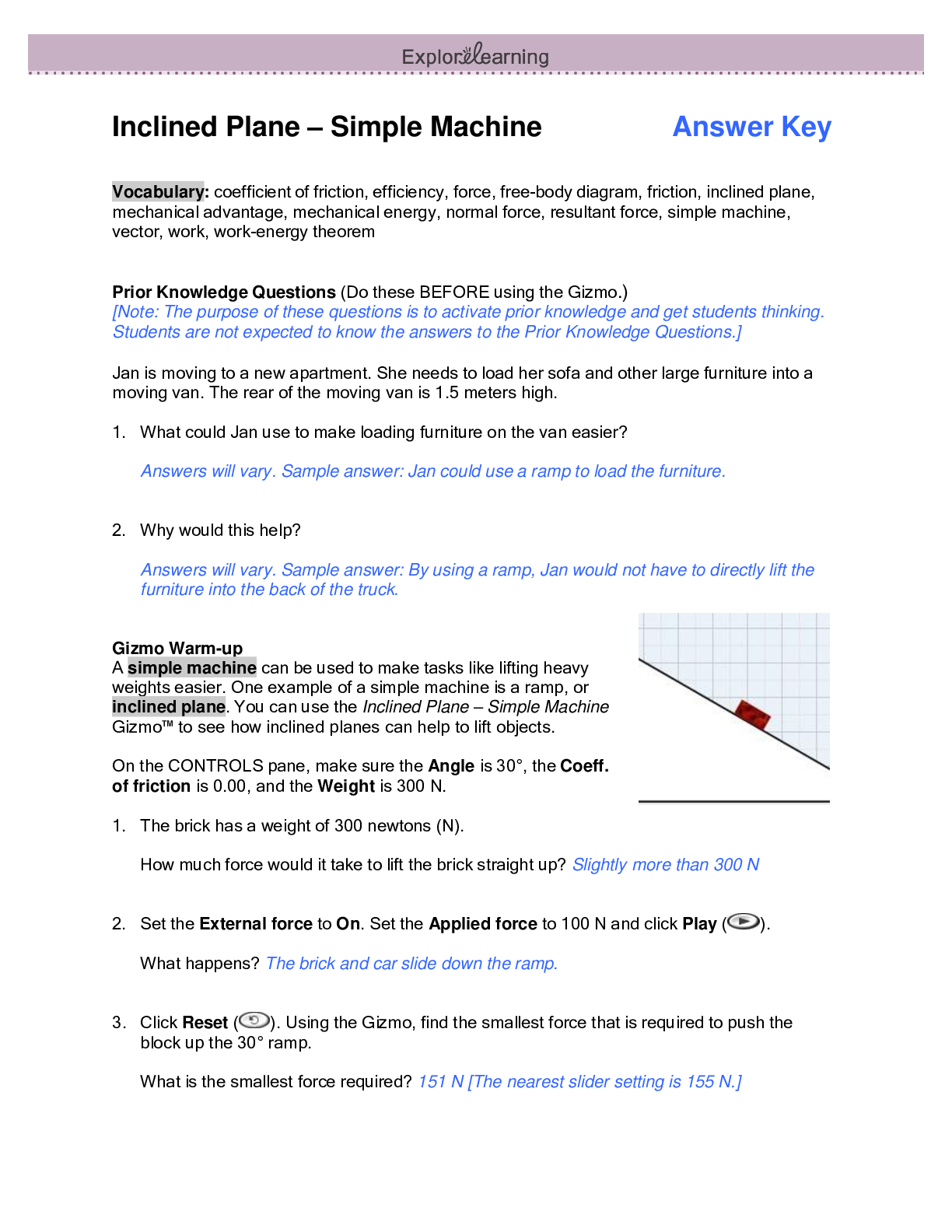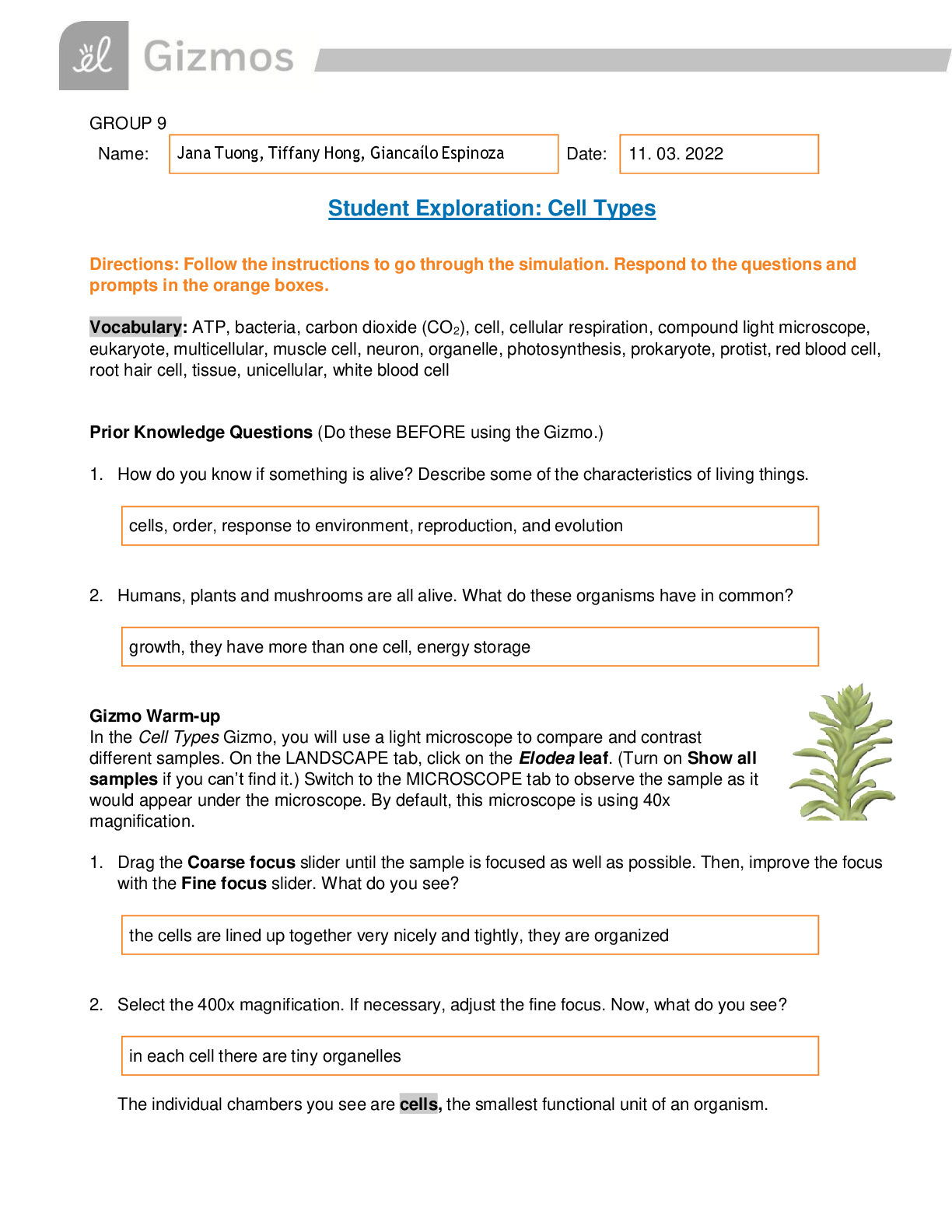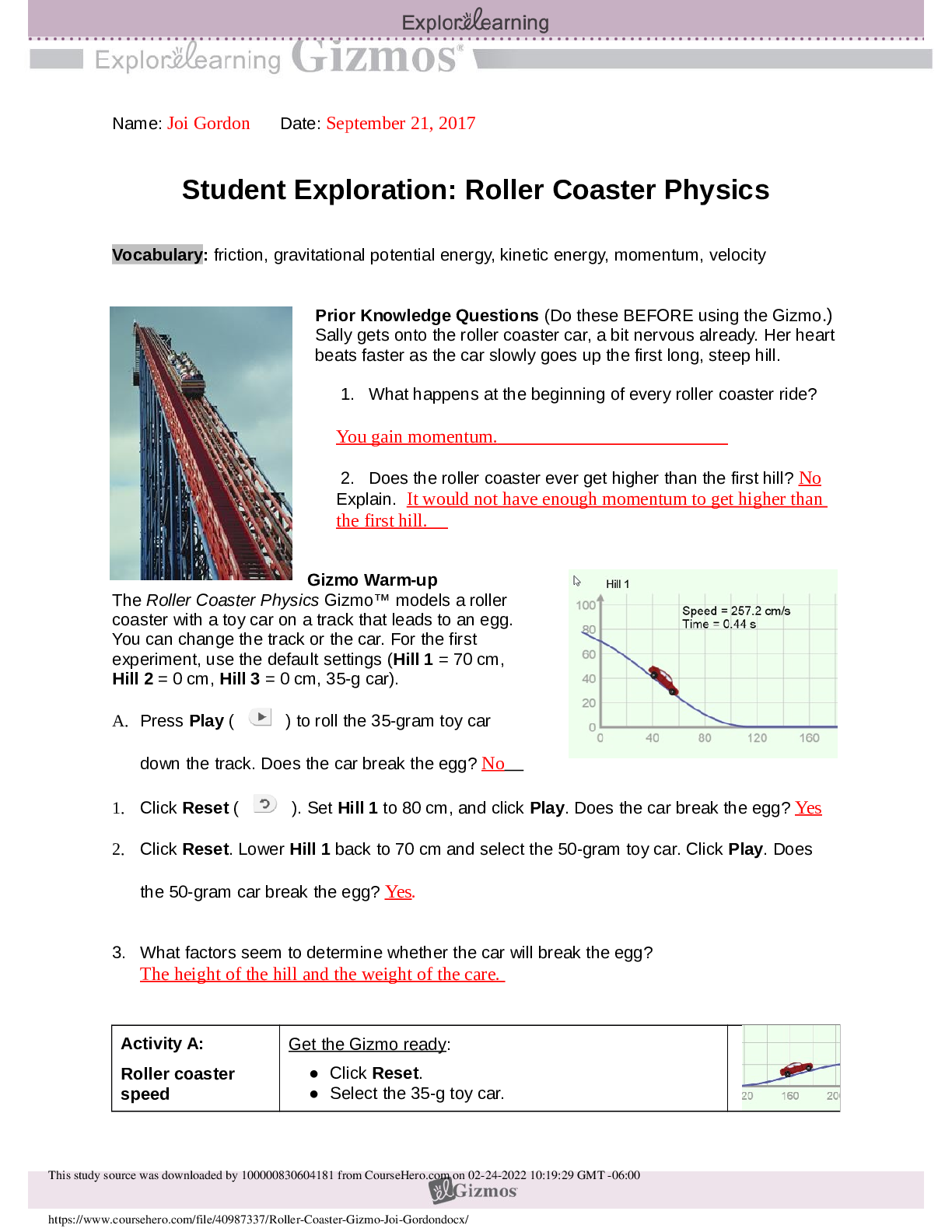GIZMO Reaction Energy -ALL ANSWERS CORRECT-VERIFIED A+
Document Content and Description Below
Student Exploration: Reaction Energy Vocabulary: calorimeter, chemical bond, endothermic, enthalpy, exothermic, Hess’s law Prior Knowledge Questions (Do these BEFORE using the Gizmo.) 1. Two magn... ets are stuck together. What might you have to do to get them to separate? 2. Suppose you held two magnets a short distance apart, then let go. What would happen? 3. Think about the magnets in terms of energy. In which case do you increase the potential energy of the magnets? In which case do you increase the kinetic energy of the magnets? Gizmo Warm-up Just like magnets, atoms of different elements are attracted together to form chemical bonds. Breaking these bonds requires energy. When a new bond forms, energy is released and temperatures rise. In the Reaction Energy Gizmo, you will explore how the energy of chemical bonding relates to temperature changes that occur during chemical reactions. To begin, check that Reaction 1 and Forward are selected. In this reaction, hydrogen (H2) and oxygen (O2) react to form water (H2O). The reaction takes place inside a device called a calorimeter. Inside the calorimeter, a small chamber holds the reactants. The rest of the calorimeter is filled with water. Exert force on both in and pull in opposite direction of the bond. They would be pulled towards each other. You increase the potential energy when holding the two magnets close to each other but not touching. You increase the kinetic energy when you let go and let them connect. As the temperature rises the hydrogen and oxygen atoms bond into water molecules.2019 1. Click Play ( ). What happens? 2. How does the temperature change?The starting temperature is 21°C and rises to 27.4°C, an increase of 6.4°C, holding at that temp once all the hydrogen and oxygen atoms are bonded.2019 Activity A: Energy of chemical bonds Get the Gizmo ready: Check that Reaction 1 and Forward are selected. Select the INVESTIGATION tab. Introduction: The heat energy stored in a chemical system is called the enthalpy (H) of the system. When atoms are joined by a chemical bond, energy must be added to pull them apart. This increases the enthalpy of the system. When a chemical bond forms, energy is released as shared electrons move into lower-energy orbitals. This causes the enthalpy to decrease. Question: How can you predict how much energy is released in a chemical reaction? 1. Predict: In the warm-up activity, you observed how the reaction inside the chamber affected the temperature of the surrounding water. Based on what happens to the surrounding water, do you think heat energy (enthalpy) is absorbed in the reaction or released? Explain. 2. Observe: In the Gizmo, the energy required to break a chemical bond is modeled by placing a molecule into a set of mechanical claws. Place one of the hydrogen (H2) molecules between the claws, and press Break bond. A. What happens? B. Look under the Energy absorbed column of the table. How much energy was required to break this bond? Note: The energy is given here in units of kilojoules per mole (kJ/mol). This is the energy, in kilojoules, required to break all of the H–H bonds in one mole of H2 gas. C. Remove the hydrogen atoms from the claws and then break apart the other H–H molecule. What is the total energy absorbed so far? 3. Measure: Notice that the oxygen atoms are connected by a double covalent bond. This is because the oxygen atoms share two pairs of electrons. Place the oxygen molecule in the claws and press Break bond. A. How much energy is required to break the first O–O bond? B. Press Break bond. How much energy is needed to break both bonds? C. What is the total energy required to break up two moles of H2 molecules and one mole of O2 molecules? Because the water heated up, the heat energy is released. If it had been absorbed then the water would have gotten colder. The claws applied force in opposite direct of about 400+ kJ/mol to break the bond. 436 kJ/mol 872 kJ/mol 349 kJ/mol 495 kJ/mol 1,367 kJ/mol2019 (Activity A continued on next page)2019 Activity A (continued from previous page) 4. Create: Remove the two oxygen atoms from the claws. Now the claws disappear and you see a template for creating a water molecule. Drag an oxygen and a hydrogen atom into the template. (If necessary, use the Key on the right-hand side as a reference.) A. Click Create bond. What happens? B. The “jiggling” animation you see represents the release of kinetic energy that occurs when a bond is formed. How much energy was released? C. Drag another hydrogen molecule into the template and click Create bond to make a water molecule. What is the total energy released so far? D. Drag the first water molecule away from the template, then use the Gizmo to create a second water molecule. What is the total energy released now? 5. Calculate: Compare the energy absorbed in breaking up the molecules to the energy released when new bonds are formed. A. In this reaction, was more energy absorbed or released? B. How does this relate to the change in temperature observed for this reaction? C. The change in enthalpy (∆H) of the system is equal to the total energy absorbed minus the total energy released. What is the ∆H value for this reaction? Compa [Show More]
Last updated: 2 years ago
Preview 1 out of 14 pages

Buy this document to get the full access instantly
Instant Download Access after purchase
Buy NowInstant download
We Accept:

Reviews( 0 )
$11.00
Can't find what you want? Try our AI powered Search
Document information
Connected school, study & course
About the document
Uploaded On
Jun 25, 2021
Number of pages
14
Written in
Additional information
This document has been written for:
Uploaded
Jun 25, 2021
Downloads
0
Views
232














